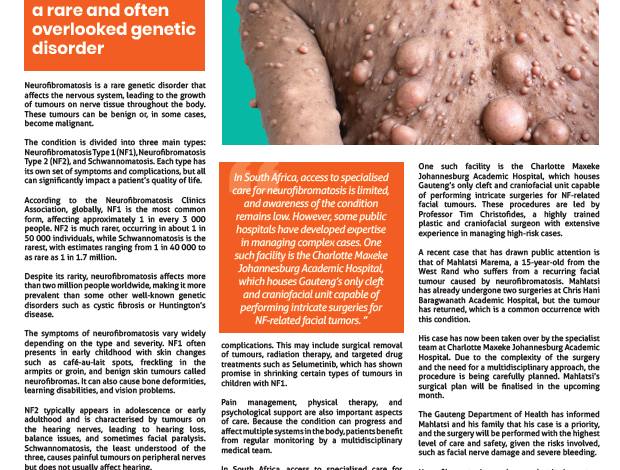What is Neurofibromatosis? Understanding the Condition and Recognising Symptoms

Table of contents
- What is Neurofibromatosis?
- The Three Types of Neurofibromatosis
- How Common is it?
- Symptoms to Watch For
- Can Neurofibromatosis Be Cured?
- Neurofibromatosis in South Africa
- A Real-Life Example: Mahlatsi Marema
- Why Early Detection and Awareness Matter
- Hope for the Future
- Pathways for Better Neurofibromatosis Care
What is Neurofibromatosis?
Neurofibromatosis (NF) is a rare genetic disorder that causes tumours to form on nerves throughout the body. These tumours are often non-cancerous (benign), but in some cases, they may become cancerous (malignant).
The condition affects both the nervous system and skin, and it can lead to serious health complications if not properly managed. Although rare, NF is more common than many people think—and more common than some other well-known genetic conditions, like Huntington’s disease or cystic fibrosis.
The Three Types of Neurofibromatosis
There are three main types of neurofibromatosis:
1. Neurofibromatosis Type 1 (NF1)
- Most common form, affecting 1 in 3,000 people worldwide.
- Usually diagnosed in early childhood.
- Symptoms include:
- Café-au-lait spots (light brown skin patches)
- Freckles in the armpits or groin
- Benign tumours called neurofibromas
- Bone deformities
- Learning difficulties
- Vision problems
2. Neurofibromatosis Type 2 (NF2)
- Much rarer, seen in 1 in 50,000 people.
- Typically develops in teen years or early adulthood.
- Main symptoms:
- Tumours on hearing nerves (called vestibular schwannomas)
- Hearing loss
- Balance issues
- Facial weakness or paralysis
2.1. Neurofibromatosis Type 2: Schwannomatosis
- Rarest type: ranges from 1 in 40,000 to 1 in 1.7 million.
- Causes painful tumours on peripheral nerves.
- Unlike NF2, it does not usually cause hearing problems (not on the eighth cranial nerve).
How Common is it?
Despite being considered “rare,” neurofibromatosis affects more than 2 million people globally. In South Africa, exact numbers are unclear due to low levels of awareness and underdiagnosis, but health experts believe many cases go undetected.
Symptoms to Watch For
Symptoms vary based on the type of NF and the individual. Early detection can help with treatment and management.
Common signs include:
- Multiple café-au-lait spots on the skin
- Lumps under the skin or along nerves
- Hearing issues or balance problems
- Chronic pain or numbness
- Vision changes
- Learning delays (especially in children)
Can Neurofibromatosis Be Cured?
There is no known cure for neurofibromatosis. However, there are many treatments to manage symptoms and complications. These include:
- Surgery: to remove tumours when they cause pain or pressure
- Radiation therapy: in rare cases where tumours are cancerous
- Medication: such as Selumetinib, which is used in children with NF1 to shrink certain tumours
- Pain management and physical therapy
- Psychological support
Regular check-ups with a multidisciplinary medical team are essential for managing the condition effectively over time.
Neurofibromatosis in South Africa
Access to specialised care in South Africa is limited, but improving. Some public hospitals have developed expertise in handling complex NF cases.
One key facility is the Charlotte Maxeke Johannesburg Academic Hospital, which houses Gauteng’s only cleft and craniofacial unit. This unit is capable of performing delicate surgeries for NF-related facial tumours. These procedures are led by Professor Tim Christofides, a leading plastic and craniofacial surgeon.
A Real-Life Example: Mahlatsi Marema
A 15-year-old boy from West Rand, Mahlatsi Marema, has undergone two surgeries at Chris Hani Baragwanath Hospital for a recurring facial tumour caused by NF. The tumour returned, which is common with this condition.

His care has now been transferred to the expert team at Charlotte Maxeke Hospital, where a carefully planned surgery is expected to take place soon. The procedure carries risks such as facial nerve damage and bleeding, but the medical team is committed to ensuring his safety and recovery.
Why Early Detection and Awareness Matter
Neurofibromatosis can have a big impact on quality of life, especially if left untreated. Early recognition of symptoms and access to specialised care can help manage the condition and reduce complications.
Public education is key. Many South Africans may not be aware of the symptoms or even the existence of this disorder.
Hope for the Future
More research, training, and health policy focus are needed to improve support for people living with NF in South Africa.
Efforts must include:
- Better access to genetic testing and diagnosis
- Specialised treatment centres
- Public awareness campaigns
- Funding for rare disease research
With the right investment and awareness, people living with neurofibromatosis can enjoy longer, healthier lives.
Early detection is key to managing shingles. Shingles: Recognizing the Symptoms. Learn the warning signs, from painful rashes to nerve discomfort, and when to seek medical help.
Pathways for Better Neurofibromatosis Care
Neurofibromatosis is a complex genetic disorder that, while considered rare, affects millions globally and presents significant challenges for those impacted. Understanding the different types; NF1, NF2, and schwannomatosis; and recognizing early symptoms can greatly improve outcomes through timely management and care. Although there is no cure yet, advances in treatment and multidisciplinary care offer hope in managing symptoms and improving quality of life.
In South Africa, increased awareness, better access to specialised treatment, and dedicated medical teams provide crucial support for patients living with NF, exemplified by cases like Mahlatsi Marema. Continued research, public education, and healthcare investment are essential to enhance early diagnosis, treatment options, and support services, ensuring that those affected by neurofibromatosis can lead healthier, fuller lives. With growing awareness and evolving medical approaches, there is genuine hope for improved prognosis and quality of life for neurofibromatosis patients around the world.



